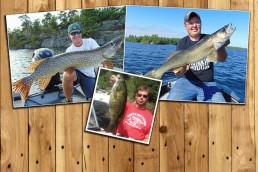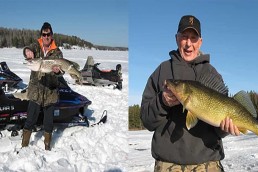Saginaw Bay: Best Big-water Bite Ever
No one can deny that even the most diehard big-water angler will feel somewhat intimidated the first time he sees the frozen facade covering Michigan’s Saginaw Bay. After all, looking out at this humongous cove of Lake Huron after it freezes over, one quickly realizes that 1,143 square miles of ice for anglers to explore equates to a lifetime of drilling holes and catching fish.
Luckily, the list of species that roam below the hoarfrost here is long, and their populous great. Even the most novice angler stands a good chance at landing a limit, and, perhaps, the biggest fish of their life the very first time they fish the bay.
The room to wander and the plethora of fish make Saginaw Bay one of the top ice fishing destinations in the entire Midwest. And it doesn’t hurt that it’s one of the first bodies of water of the Great Lakes to acquire safe ice and one of the last to lose it.
So how does one go about fishing such a large expanse of water without feeling overwhelmed?
By breaking the portions of the bay down as if they were smaller bodies of water, and changing up techniques as winter runs its course, the bay becomes more angler friendly. And the same methods will work wonders no matter what species comes swimming your way.
Variety pack
First, let’s talk about the different species that call Saginaw Bay home.
Without a doubt, this waterway has been a destination for anglers looking to catch walleyes for decades. It’s because the lay of the “underwater” land here is nothing but perfect habitat for this normally fickle fish. In fact, the walleye population here is at an all-time high, thus the size limit on the bay as well as portions of the Saginaw River have been reduced from 15 inches down to 13, and the daily creel limit upped to eight fish from five.
Yellow perch have been a target for anglers within the last century. While good catches of 8- to 13-inch perch are reported every winter, the creel was just lowered from 50 fish to 35, as numbers of young-of-the-year fish are down; the increase in the walleye populous is a possible culprit.
Two other highly-sought after gamefish, lake trout and whitefish, have been making their way into Saginaw Bay over the last decade.
Both considered more deep-water species (in depths well over 100 feet, much deeper than the 48-foot average depth of the bay), they have been caught in large numbers in water as shallow as 4 feet. It’s thought these two classic Great Lakes natives have discovered the invasive round goby as a major food source, and as proven by the numerous catches, have no issue hunting in shallow water for this forage.
In reality, ice fishing guides like Brandon Stanton (teamgunsmokesportfishing.com) feel there’s no need to specifically target lake trout or whitefish.
“Both species follow the same cuts and gullies as other species, and will hit the same baits. In fact, I have had to move my clients who want to catch walleyes to different areas because those two fish were so plentiful, it ended up that’s all we were catching,” he claims.
Never be surprised at the species you may find attacking your lure at Saginaw. The occasional smallmouth and largemouth (two out of season when ice fishing), crappie and roughfish like catfish and sheepshead are likely to be caught as well.
Big-water travel
Although there are some areas that can be ice fished on foot in winter—mostly on the east side from Caseville to Sebewaing—Saginaw Bay is such big water that quads or snowmobiles are required.
Like any large body of water, the safest way to ice fish the bay is to never fish it alone. Cracks and heaves form often, so take your time to and from fishing. And depending on where you launch from, travel is often several miles from your starting point. Taking both a GPS and compass is a must, which will not only help you get to your fishing spot, but safely back to shore.
Gear essentials
There’s no fancy equipment needed to ice fish Saginaw Bay: a medium-light ice rod and matching reel, filled with 8-pound-test superline coupled with a 6- to 8-pound-test fluorocarbon leader, a portable ice shanty and heater to keep you comfortable all day long and snacks.
One critical piece of equipment is a high-quality sonar (aka: fish finder) for determining depth and seeing fish. One that has a card reader for a SD card filled with a hydrographic mapping program showing contours to help you pinpoint exact areas for the ideal fishing is best. Overall, look for cuts that come in from deeper water and fish as close to the breaklines as you can. And never be afraid to move—even just mere feet—if you’re not catching fish. The bay is filled with humps, bumps and rock piles, and small moves can make a big difference.
First to last
At first ice, Stanton uses large spoons and a “hostile” jigging motion to catch fish.
“There’s still plenty of oxygen in the water and fish are aggressive,” he says.
As the season wanes, the jigs he ties on get smaller, and his approach is a little more relaxed. By last ice, Stanton can be found tying on tiny jigs and giving his bait nearly no movement at all. And no matter what time of year, he always tips his lures with minnows or soft plastics infused with scent.
Huron’s big bay
This winter, give Saginaw Bay a try. Just remember, there’s no need to be intimidated. Break down the bay into lesser areas and fish them like they are smaller lakes. Don’t be afraid to move if the bite’s not happening, and change your approach as the season changes.
Schooled on the Bay”Ice fishing can seem daunting, especially on huge expanses of water that are unapproachable. Enter walleye pro Mark Martin and his team of top-notch fishing instructors.For years now, Martin and his crew have been turning ice fishing into a fine art for his students during his Ice-Fishing Vacation/Schools held throughout the Midwest.
“Many come to the school on Saginaw Bay just to be able to fish this huge body of water with others,” Martin says. “But no matter what, everyone learns something valuable at the event; including myself. It’s a win, win for all of us.”
Check out markmartins.net and fishingvacationschool.com for more information.
MWO
SHARE THIS POST
You may also like...
Did you enjoy this post?
You can be among the first to get the latest info on where to go, what to use and how to use it!
Mark Martin
Mark Martin is a professional walleye tournament angler and instructor with the Ice Fishing School/Vacation series. For more information, check out his website at markmartins.net or fishingvacationschool.com.



